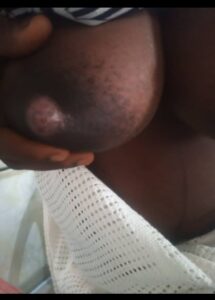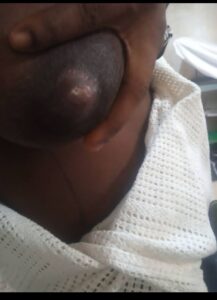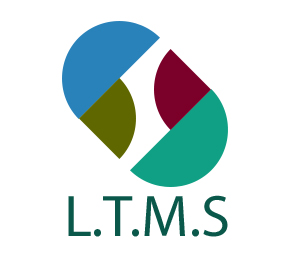
ALTH
 `
`
`MASTITIS“`
*CAUSES, TYPES, SYMPTOMS AND MANAGEMENT*
WHAT IS MASTITIS?
Mastitis is an infection that develops in breast tissue. The painful condition causes one breast to become swollen, red and inflamed. In rare cases, it affects both breasts. Mastitis is a type of benign (noncancerous) breast disease.
WHAT CAUSES MASTITIS?
Mastitis occurs when bacteria found on skin or saliva enter breast tissue through a milk duct or crack in the skin. Milk ducts are a part of breast anatomy that carry milk to the nipples. All genders have milk ducts and can get mastitis.
Infection also happens when milk backs up due to a blocked milk duct or problematic breastfeeding technique. Bacteria grow in the stagnant milk. These factors increase the risk of a nursing mom developing mastitis:
• Cracked, sore nipples.
• Improper latching technique or using only one position to breastfeed.
• Wearing tight-fitting bras that restrict milk flow.

ALTH
WHAT ARE THE SYMPTOMS OF MASTITIS?
Many people with mastitis develop a wedge-shaped red mark on one breast. (Rarely, mastitis affects both breasts.) The breast may be swollen and feel hot or tender to touch. You may also experience:
√ Breast lumps.
√ Breast pain (mastalgia) or burning sensation that worsens when your baby nurses.
√ Fatigue.
√ Flu-like symptoms, including fever and chills.
√ Headaches.
√ Nausea and vomiting.
√Nipple discharge.
WHAT ARE THE TYPES OF MASTITIS?
The different types of mastitis include:
*Lactation*: This infection type affects breastfeeding women. Also called puerperal mastitis, it’s the most common.
*Periductal*: Menopausal and postmenopausal women and smokers are more prone to periductal mastitis. Also called mammary duct ectasia, this condition occurs when milk ducts thicken. The nipple on the affected breast may turn inward (inverted nipple) and produce a milky discharge.
DOES MASTITIS INCREASE MY RISK OF BREAST CANCER?

ALTH
NO! Mastitis doesn’t increase your risk of breast cancer. However, mastitis symptoms are similar to inflammatory breast cancer symptoms. This rare type of breast cancer causes breast skin changes. Signs may include dimples and a breast rash that has an orange-peel texture. Like mastitis, one or both breasts may become red and swollen. Inflammatory breast cancer doesn’t usually cause breast lumps.
Inflammatory breast cancer is an aggressive cancer. It requires prompt diagnosis and treatment. Contact or visit our Medical professional at Adebayo Living Tower Hospital right away any time you notice breast changes.
IS IT SAFE TO CONTINUE BREASTFEEDING WHEN I HAVE MASTITIS?
Yes, you should continue to nurse your baby. You can’t pass a breast infection to your baby through breast milk. In fact, breast milk has antibacterial properties that help babies fight infections. Antibiotics that our Medical professional Doctor at Adebayo Living Tower Hospital prescribes for mastitis are also safe for your baby.
It may be uncomfortable to nurse when you have mastitis. But breastfeeding helps move milk through milk ducts, opening them up. When nursing, start your baby on the affected breast first. That way, you’ll ensure milk doesn’t stay in the milk ducts and allow bacteria to grow.
WHO MIGHT GET MASTITIS?
Mastitis most commonly occurs during the first six to 12 weeks of breastfeeding. But men, as well as women who aren’t breastfeeding, also get mastitis. You’re more likely to get mastitis if you have:
• Breast implants.
• Diabetes or other autoimmune disease.
• Eczema or similar skin condition.
• Nicks in skin from plucking or shaving chest hairs.
• Nipple piercing.
• Tobacco or nicotine addiction (smoking).
CAN I GET MASTITIS MORE THAN ONCE?

ALTH
Yes, it’s possible to get mastitis multiple times. If you’re breastfeeding and frequently get mastitis, our Medical professional at adebayo living tower hospital may recommend seeing our lactation consultant (breastfeeding specialist). There may be a problem with how the baby is positioned or latches on during nursing.
WHAT ARE THE COMPLICATIONS OF MASTITIS?
If left untreated, a breast infection like mastitis can lead to a breast abscess. This type of abscess typically needs to be surgically drained. If you have an abscess that needs to be drained, our Medical professional Doctor at Adebayo Living Tower Hospital will perform minor surgery or use a small needle to drain the pus. Often, you may need to be admitted to the hospital for IV antibiotics. A breast abscess will not go away with warm compresses.
HOW CAN I PREVENT MASTITIS?
Breastfeeding moms can take these steps to lower their chances of getting mastitis:
• Air out your nipples after nursing.
• Don’t wear nursing pads or tight-fitting bras that keep nipples moist.
• Nurse your baby on one side, allowing the breast to empty, before switching to the other breast.
• Switch up breastfeeding positions to fully empty all areas of the breast.
• Use your finger to break your baby’s suction on a nipple if you need to stop a feeding.
OUR DIAGNOSIS ON MASTITIS
Our medical professional at Adebayo living tower hospital will do a physical exam and check your symptoms to make a diagnosis. If you aren’t breastfeeding, you may get a mammogram or other tests to rule out breast cancer or a different breast condition.

ALTH
OUR MANAGEMENT AND TREATMENT
AT ADEBAYO LIVING TOWER HOSPITAL
Our medical professional Doctor at Adebayo living tower hospital may prescribe an oral antibiotic to treat mastitis. The infection should clear up within 10 days but may last as long as three weeks. Mastitis sometimes goes away without medical treatment
Visit or contact us at Adebayo living Tower Hospital if you notice any changes on your breast.
“`I..C..T Department“`

ADEBAYO LIVING TOWER HOSPITAL
ALTH

Recent Comments